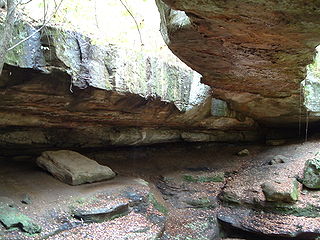Natural Rockbridge
in Hocking Hills, Ohio
Ohio
is a land of diverse geological features.
Among the most unusual and spectacular
formations are its natural rock bridges.
Ohio has at least 12 such bridges. These
bridges (or stone arches) have been found
primarily in the area characterized by
massive sandstone outcroppings in south
central and eastern Ohio. Very few have been
discovered in the limestone region of
southwest Ohio although natural bridges are
often associated with such weathered
limestone topography.

Rockbridge Natural Bridge originated
millions of years ago, when Ohio lay under a
warm inland sea. Rivers flowed into the vast
body of water, carrying both fine and coarse
grained sands which settled to the sea
bottom. Over the centuries, the accumulating
sand thickened, compressed and formed the
hard sedimentary rock known as Black Hand
Sandstone. Eventually, great pressure from
beneath the earth's surface caused the land
in eastern North America to rise, forming
the Appalachian Mountains. The inland sea
soon drained away, exposing the newly
uncovered rock layers to steady erosional
processes. The natural bridge soon began
emerging in all its grandeur. Wind, rain and
percolating groundwater worked together for
centuries, carving a deep cave-like recess
in the softer midportion of the
Mississippian Black Hand Sandstone.
Gradually, erosional forces also worked
along a natural joint plane some distance
behind the brink of the cliff. Over the
centuries, this ongoing process has widened
the crevice, and all that remains of the
overhanging ledge is the narrow rock arch.
The natural arch or bridge known as
Rockbridge is more than 100 feet long and 10
to 20 feet wide, and gracefully arches 50
feet across a ravine. It is considered the
largest natural bridge in the state. Only
the Ladd Natural Bridge in Washington County
rivals it in size. |
|